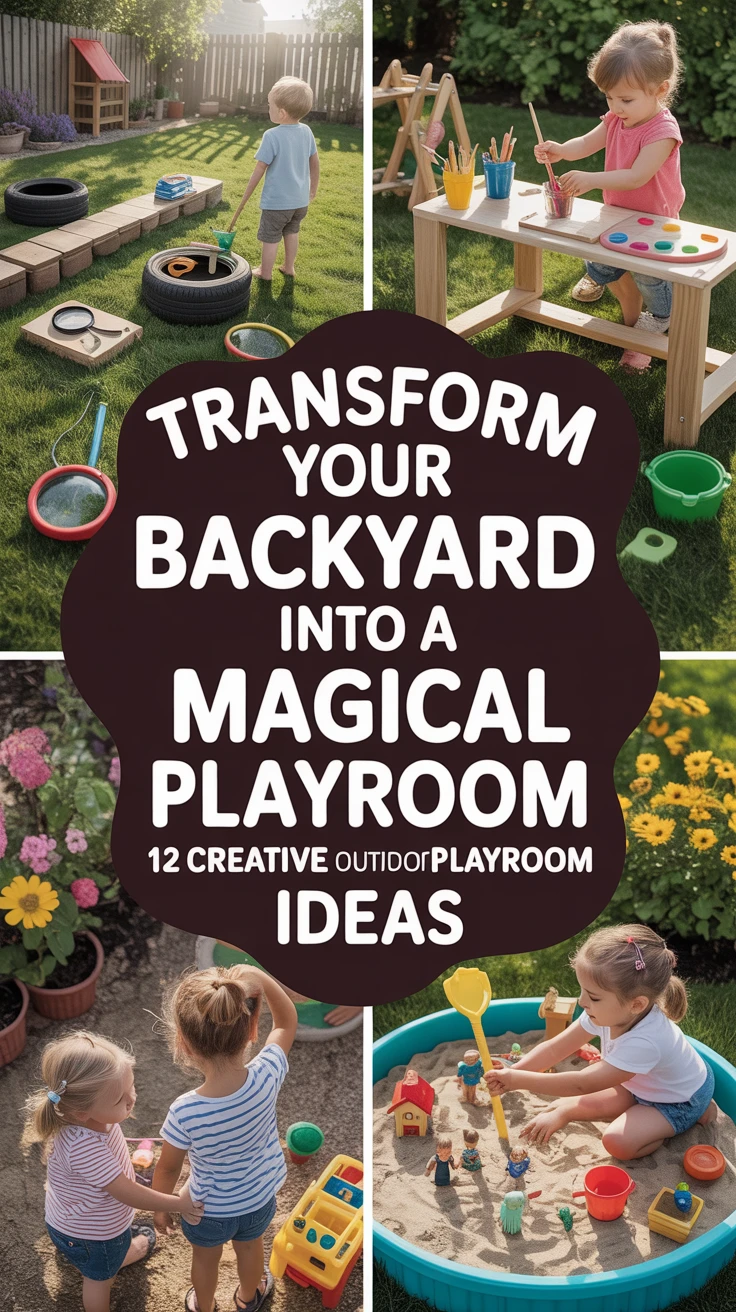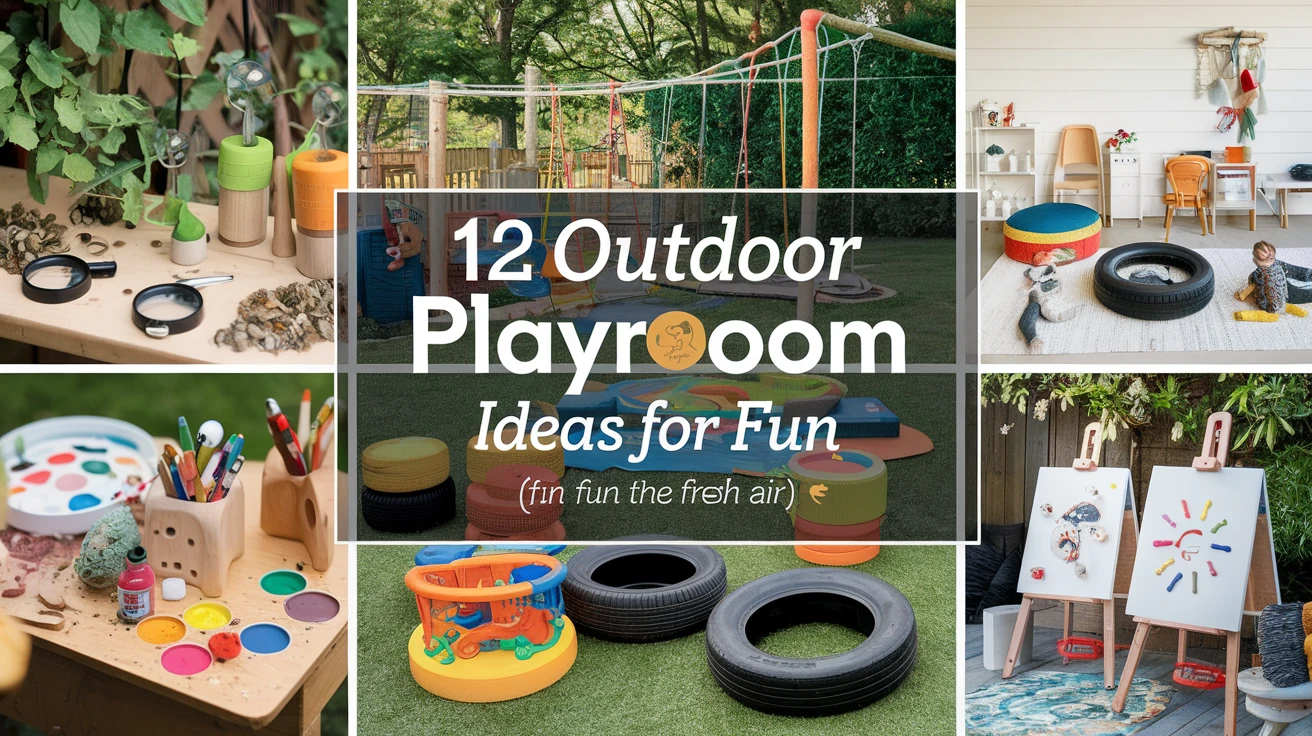
When the walls start closing in and the indoor toys have lost their luster, it’s time to think beyond the traditional playroom. Outdoor playroom alternatives offer the perfect solution for energetic kids and sanity-seeking parents alike. Not only do these fresh-air play spaces provide a change of scenery, but they also offer incredible developmental benefits that indoor environments simply can’t match. From enhanced physical activity to sensory exploration and a deeper connection with nature, the great outdoors becomes the ultimate playground with just a little creativity and planning.
Whether you’ve got a sprawling backyard or just a modest patio space, I’m about to share 12 fantastic outdoor playroom ideas that’ll transform your exterior space into a childhood paradise. The best part? Many of these can be implemented without breaking the bank or requiring professional installation. Ready to take playtime to new heights? Let’s dive into these outdoor playroom alternatives that’ll have your kids begging to go outside!
1. Nature-Inspired Play Zones

Who needs plastic play structures when Mother Nature provides the perfect playground? Creating a nature-inspired play zone is all about working with what’s already available in your outdoor space. Start by designating an area where kids can freely interact with natural elements—think fallen logs for balance beams, stones for hopscotch, or a dedicated digging patch.
- Incorporate large rocks or stumps at various heights for climbing and jumping
- Create simple trails through garden areas for exploration
- Install a bird feeder and provide binoculars for wildlife watching
- Designate a “loose parts” area with pinecones, sticks, and leaves for creative play
We transformed a corner of our yard with three large stumps and some river rocks, and it’s become my daughter’s favorite spot for imaginative play. She calls it her “forest kingdom” and spends hours creating elaborate stories there.

View on AmazonAs an Amazon Associate, I earn from qualifying purchases.

View on AmazonAs an Amazon Associate, I earn from qualifying purchases.
Pro Tip: Rotate natural materials seasonally to keep the space fresh and exciting. Fall leaves become “gold coins” while spring flowers transform into “fairy food”—the possibilities are endless!
2. DIY Outdoor Mud Kitchens
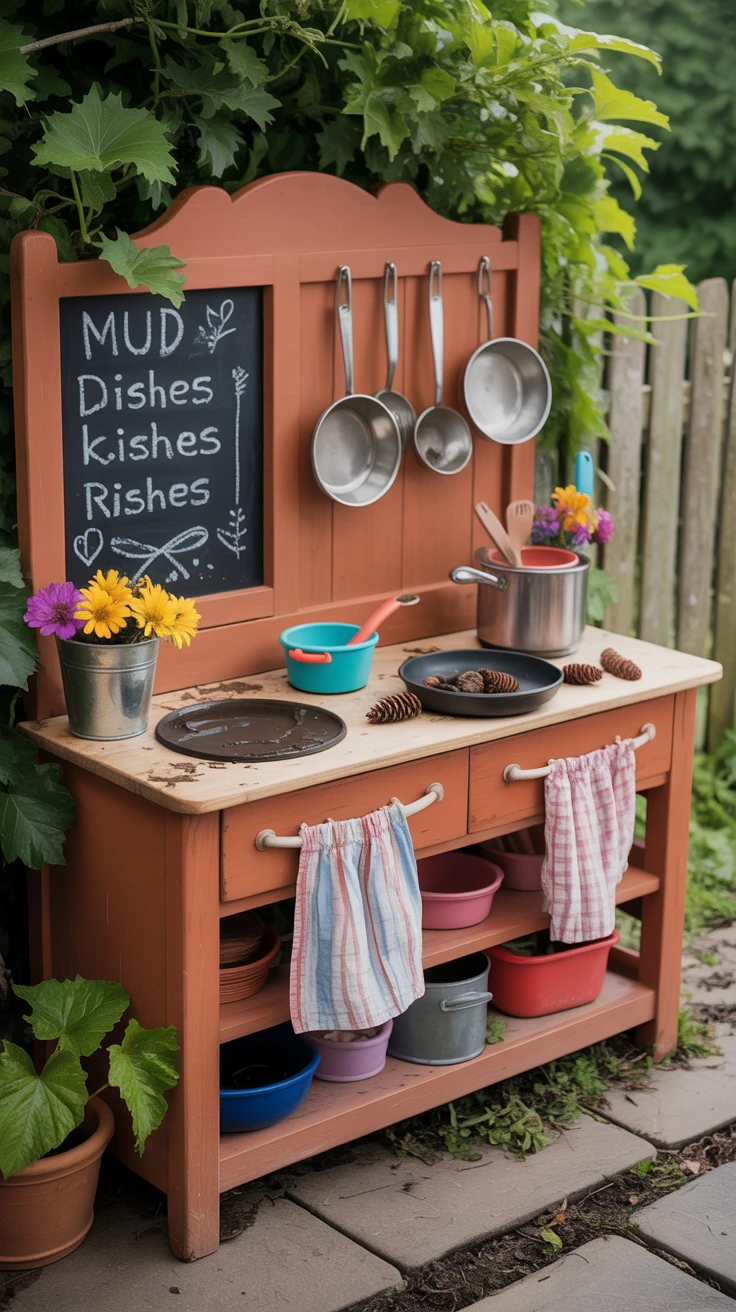
If there’s one outdoor playroom alternative that guarantees hours of messy fun, it’s a mud kitchen. These sensory-rich play stations combine creativity, pretend play, and good old-fashioned dirt in a way that’s irresistible to children of all ages.
Creating a mud kitchen doesn’t require fancy equipment—an old table or repurposed dresser can serve as your base. Add some old pots, pans, utensils, and containers from thrift stores or your own kitchen castoffs. The magic happens when you add a water source (a simple bucket works) and access to dirt or sand.
- Install a small shelf for storing “cooking” tools and containers
- Add a washbasin (an old sink or plastic tub) for water play
- Include natural “ingredients” like pinecones, pebbles, and flower petals
- Consider a chalkboard for “menus” and recipe creation
Pro Tip: Set up your mud kitchen near a hose or create a designated “cleanup station” with towels and a wash bucket. And yes, you’ll want to establish the “mud kitchen clothes” rule early on!
3. Backyard Water Play Areas
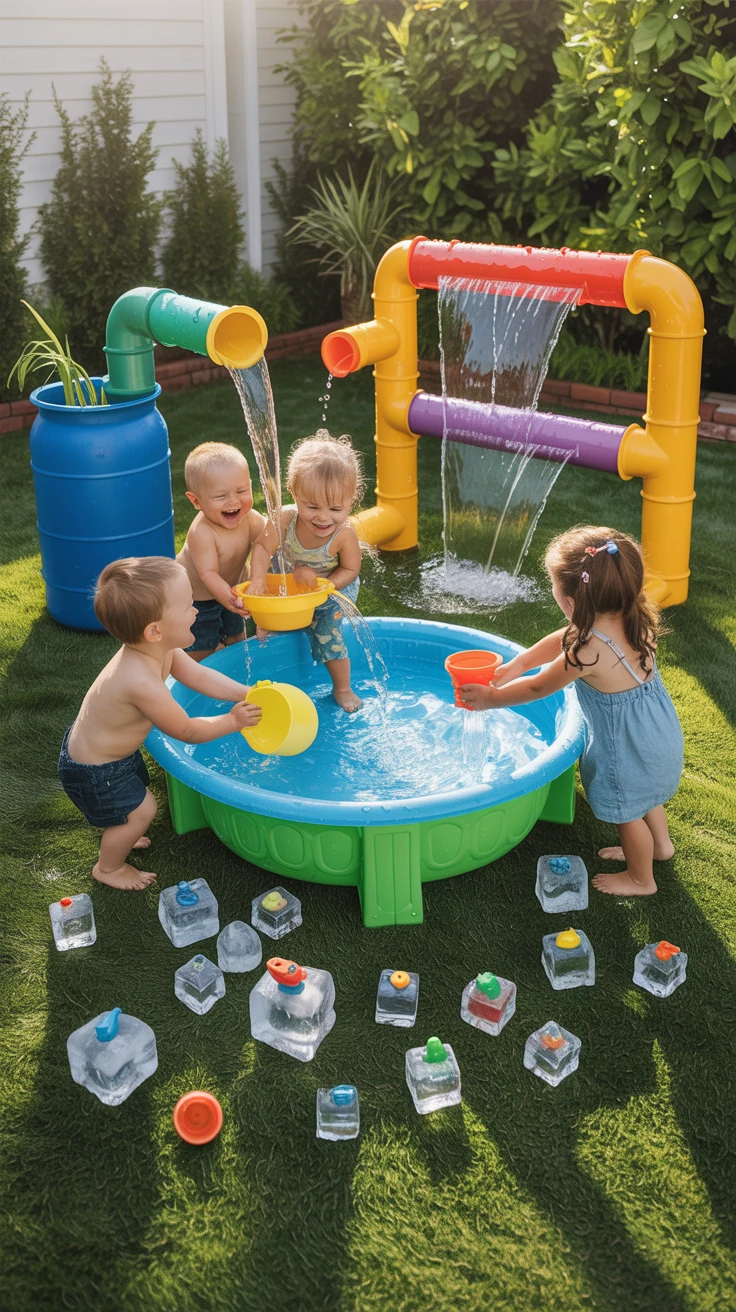
Nothing says summer fun quite like water play, and you don’t need an expensive pool to make a splash. A dedicated water play area becomes an instant hit as an outdoor playroom alternative during warmer months. The sound of giggling children splashing around is worth the minimal setup effort!
Start with a base like a water table, kiddie pool, or even a large plastic storage container. Then, enhance the experience with accessories like cups, funnels, water wheels, and squirt toys. For older kids, consider adding more complex elements like homemade water walls or simple irrigation systems they can manipulate.
- Create a water wall using PVC pipes attached to a fence or board
- Set up a “car wash” station for bikes and outdoor toys
- Add ice cubes with frozen toys inside for a melting excavation activity
- Install a rain barrel with a spigot for sustainable water play

View on AmazonAs an Amazon Associate, I earn from qualifying purchases.

View on AmazonAs an Amazon Associate, I earn from qualifying purchases.
Pro Tip: Place your water play area on a surface that can handle moisture—like grass or concrete—and away from areas where excess water could cause problems. Always supervise water play, even in shallow containers!
4. Portable Play Stations
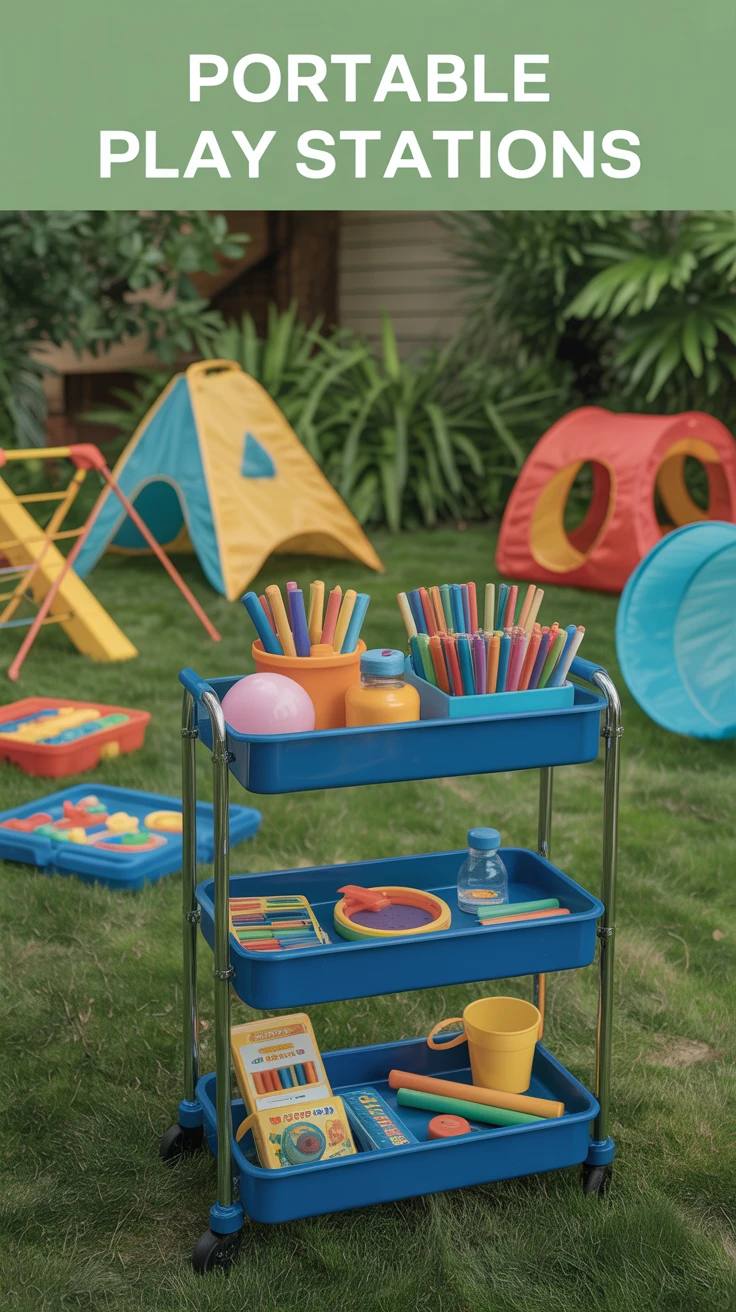
Not every outdoor playroom alternative needs to be permanent. For those with limited space or who rent their homes, portable play stations offer flexibility while still delivering tons of fun. These movable setups can be brought out when needed and stored away when not in use—perfect for balconies, shared yards, or spaces that serve multiple purposes.
The key to successful portable play stations is lightweight, weatherproof materials and smart storage solutions. Think collapsible containers, rolling carts, and items that serve multiple play purposes.
- Use a rolling cart filled with outdoor art supplies
- Create a “play pack” with chalk, bubbles, and small outdoor games
- Invest in foldable play equipment like pop-up tents or tunnels
- Design activity boxes themed around different types of play (construction, science, art)
I’ve found that keeping a dedicated “outdoor play trunk” by our back door means we’re always ready for impromptu outdoor fun. It contains everything from sidewalk chalk to magnifying glasses and bug catchers—essentials for spontaneous adventure!
Pro Tip: Label everything clearly and establish a “check-in/check-out” system for portable play items to prevent pieces from disappearing into the yard (or neighborhood).
5. Outdoor Reading Nooks
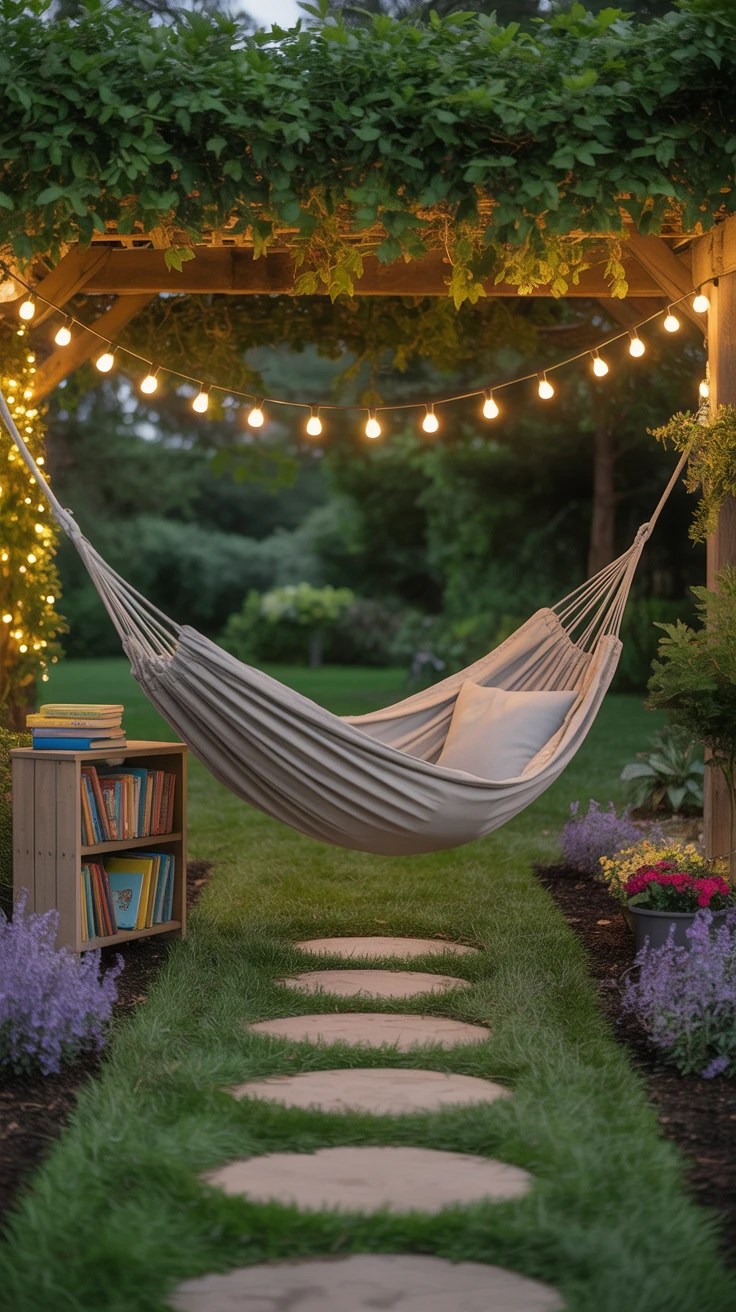
Quiet time doesn’t have to be indoor time! Creating a cozy outdoor reading nook encourages literacy while allowing kids to benefit from fresh air and natural light. These peaceful retreats become magical outdoor playroom alternatives for bookworms and children who need occasional sensory breaks.
The perfect outdoor reading nook balances comfort with durability. Weather-resistant cushions, shade protection, and accessible book storage are the three essential elements. The space should feel secluded and special—like a little literary haven.
- Hang a weather-resistant hammock or swing for swaying while reading
- Create a teepee or tent using outdoor fabric for a sheltered reading spot
- Install a small weatherproof bookshelf or use a rolling cart to bring books outside
- Add solar-powered fairy lights for magical evening reading sessions

View on AmazonAs an Amazon Associate, I earn from qualifying purchases.

View on AmazonAs an Amazon Associate, I earn from qualifying purchases.
Pro Tip: Keep a dedicated set of “outdoor books” that won’t be devastated by a light sprinkle or slightly dirty hands. Library books probably shouldn’t make the outdoor cut!
6. Artistic Outdoor Spaces
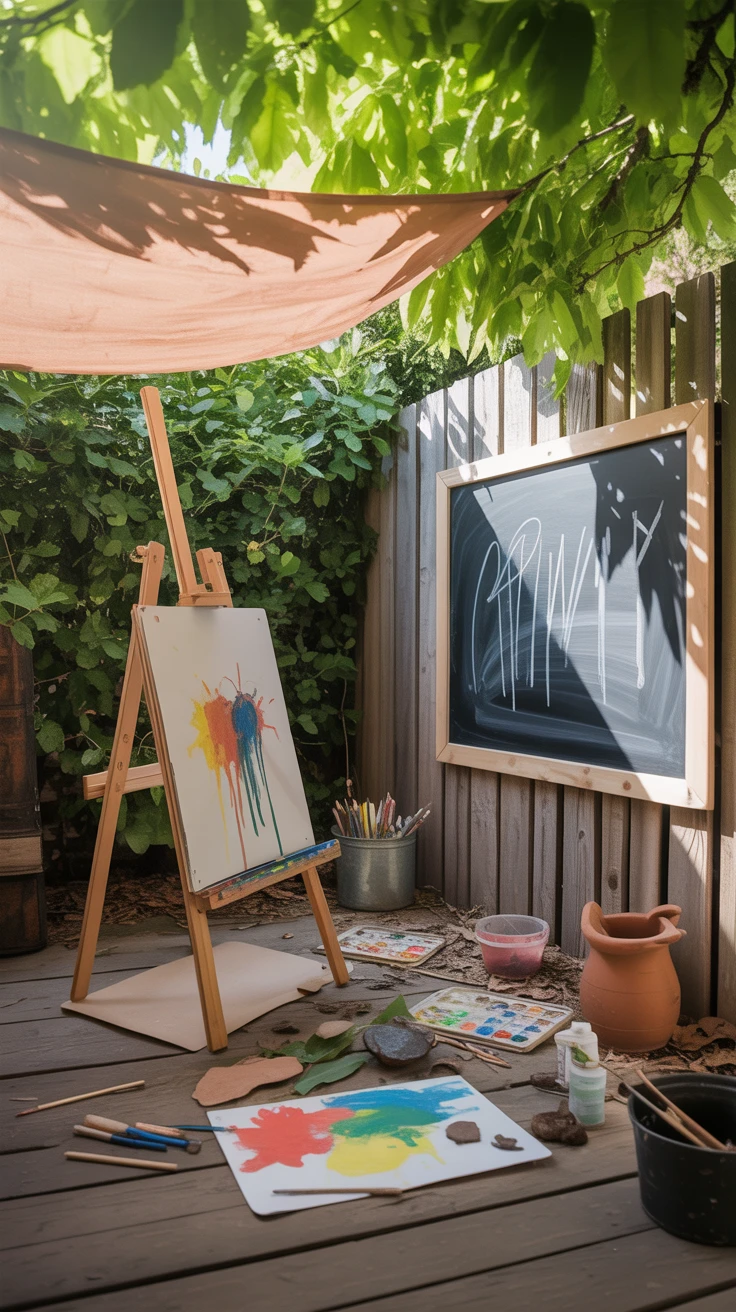
Let creativity flow in the great outdoors by establishing an artistic zone in your yard. Outdoor art spaces remove the worry about spills and messes while providing inspiration from nature. These vibrant outdoor playroom alternatives encourage self-expression and can be adapted for artists of all ages.
Start with a sturdy table or easel that can withstand the elements, then add weather-appropriate art supplies. Consider how the space will function in different weather conditions—will you need a canopy for shade or rain protection?
- Install an outdoor chalkboard or whiteboard on a fence or exterior wall
- Create a nature-based art station with clay, leaves, sticks, and natural materials
- Set up a large-scale painting area using shower curtains as drop cloths
- Designate a sidewalk chalk zone with stencils and spray bottles
Pro Tip: Invest in special outdoor art supplies like weatherproof markers, washable outdoor paint, and chunky sidewalk chalk. Store these in waterproof containers to extend their lifespan and keep them ready for spontaneous creativity sessions.
7. Adventure Play Zones
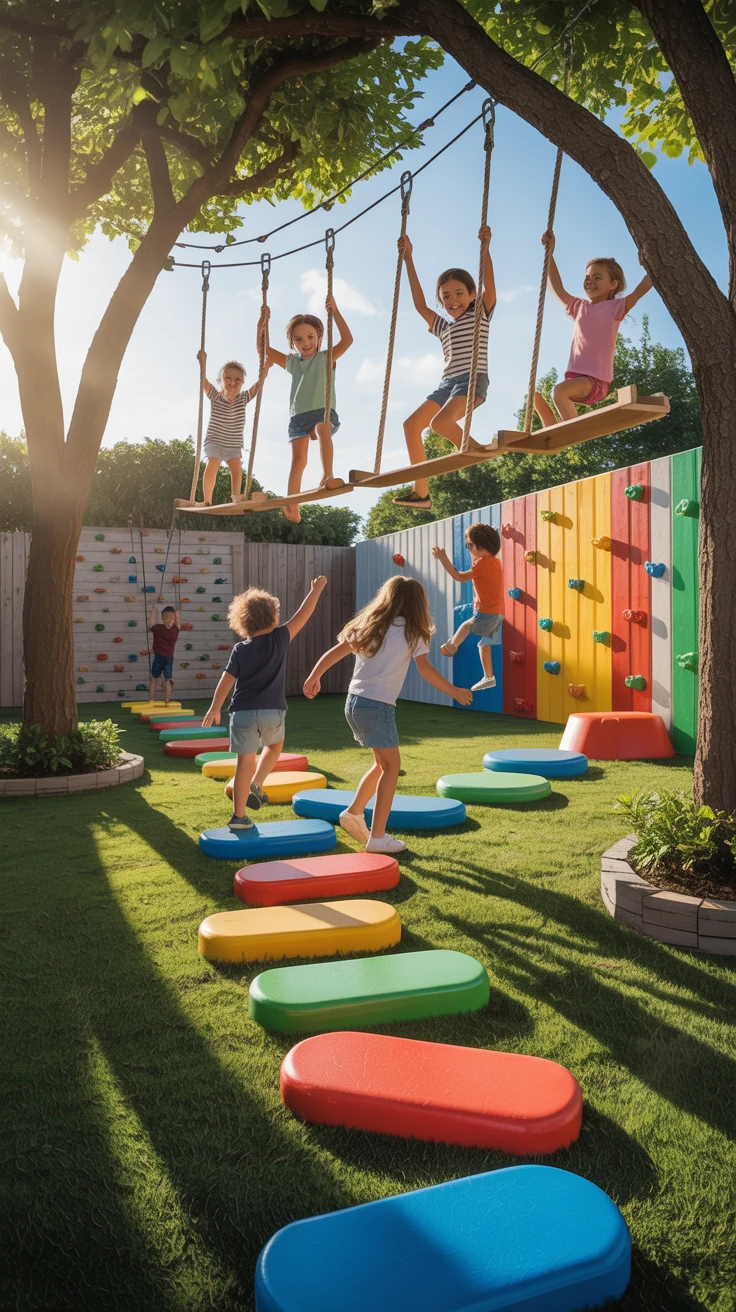
For kids who crave action and excitement, adventure play zones deliver non-stop physical challenges and thrills. These dynamic outdoor playroom alternatives focus on gross motor development, risk assessment, and building confidence through physical achievement.
The beauty of adventure play is that it can be scaled to fit your space and budget. From elaborate obstacle courses to simple balance beams, the goal is to create opportunities for physical challenge and mastery.
- Create a ninja warrior course with stepping stones, balance beams, and hanging elements
- Install a zip line between sturdy trees (with proper safety equipment)
- Build a climbing wall on a fence or shed exterior
- Design a parkour-inspired space with various jumping and climbing challenges
Last summer, we transformed our backyard into a weekend obstacle course competition zone, using pool noodles, old tires, and rope. The neighborhood kids still talk about the “Backyard Challenge” months later!

View on AmazonAs an Amazon Associate, I earn from qualifying purchases.

View on AmazonAs an Amazon Associate, I earn from qualifying purchases.
Pro Tip: Layer soft materials like mulch or sand beneath climbing elements, and always test structures yourself before allowing children to play. Gradually increase difficulty levels as kids master each challenge.
8. Weather-Protected Play Areas
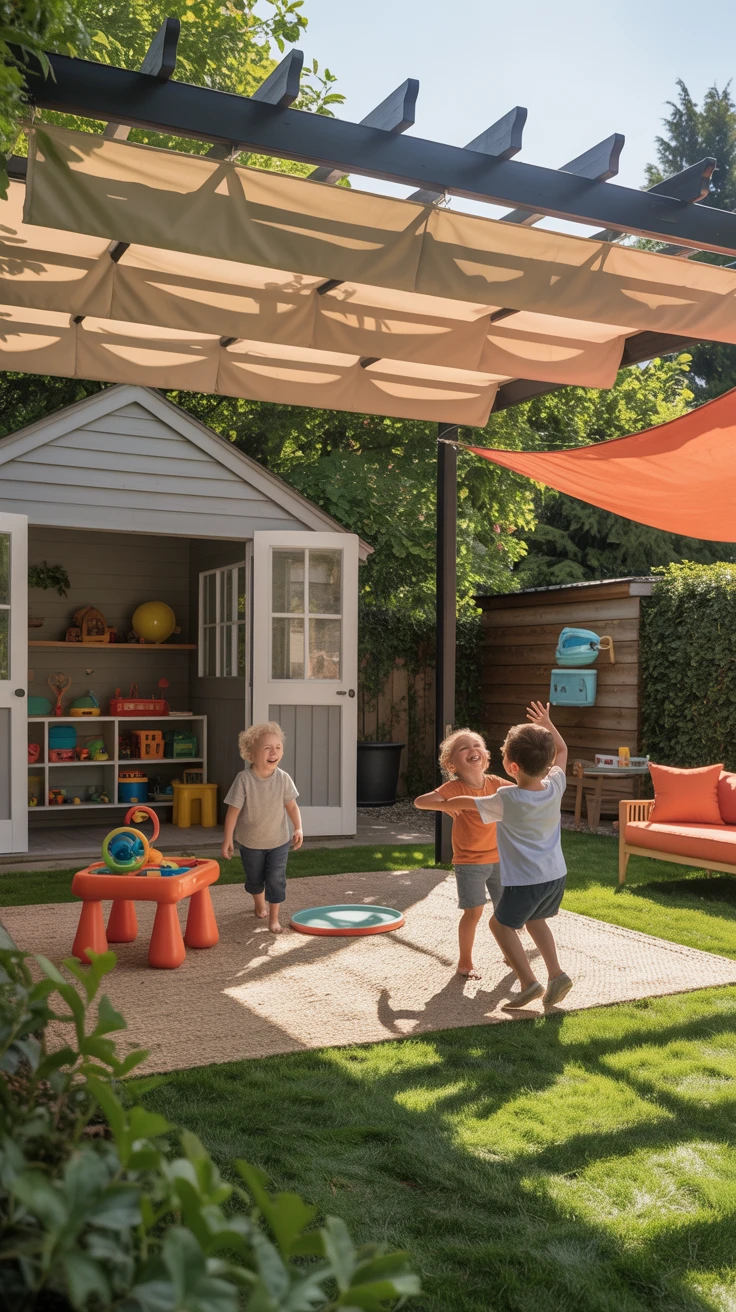
Don’t let a little rain or intense sun ruin outdoor play! Weather-protected spaces extend the usability of your outdoor playroom alternatives throughout changing conditions. These sheltered zones become particularly valuable in regions with extreme weather patterns, allowing outdoor play to continue regardless of light rain or strong sun.
The key is creating durable coverage that can withstand your local weather challenges while still maintaining the outdoor feel. This might mean different solutions depending on whether you’re primarily dealing with rain, sun, or both.
- Install a pergola with retractable weather-resistant fabric
- Create a play pavilion using a heavy-duty canopy or shade sail
- Repurpose a garden shed with windows and doors that open fully
- Build a simple lean-to structure against an existing wall
Pro Tip: Add gutters and drainage to any roofed play structure to prevent water pooling and extend the life of your outdoor playroom investment.
9. Sensory Gardens for Kids
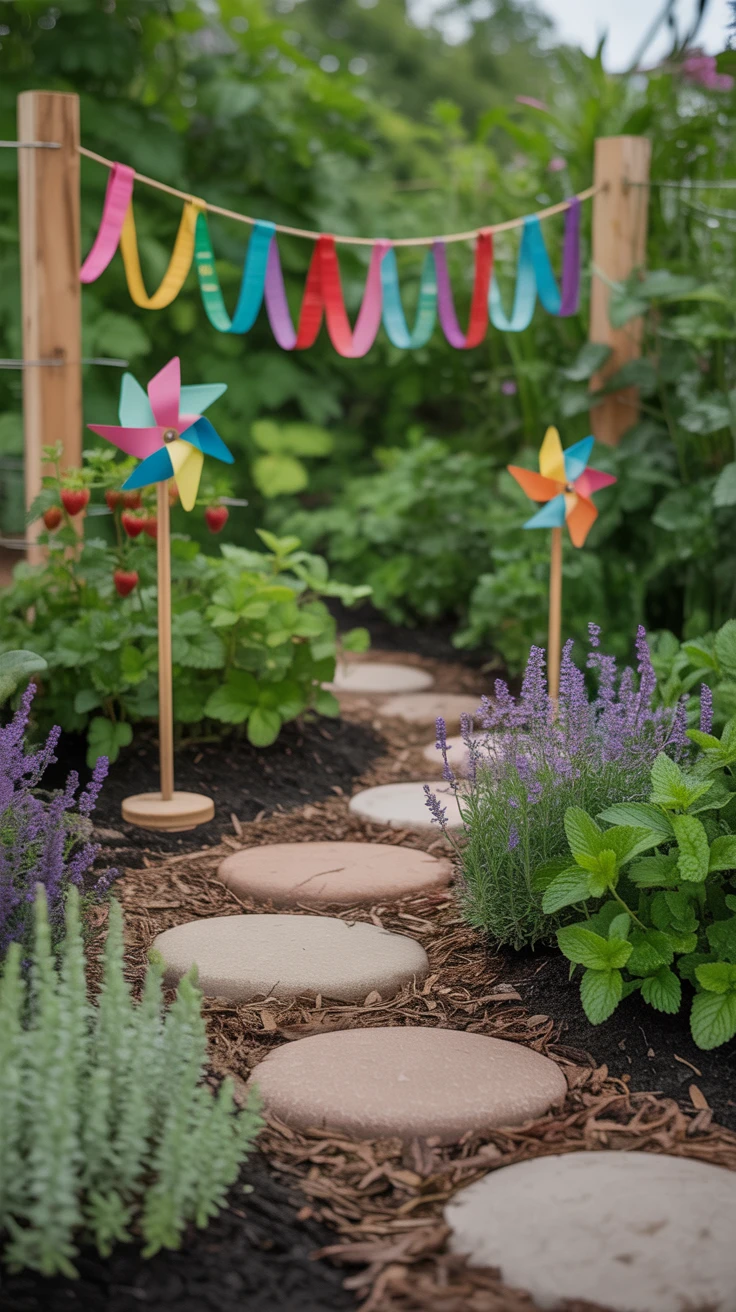
Engage all five senses with a dedicated sensory garden that doubles as an immersive outdoor playroom alternative. Unlike traditional gardens, sensory gardens are designed specifically for interaction—touching plants, smelling flowers, listening to rustling grasses, and even tasting edible varieties.
The perfect sensory garden combines plants with interactive elements like wind chimes, water features, textured stepping stones, and mirrors. The goal is to create distinct sensory experiences throughout the space.
- Plant herbs like mint, lavender, and lemon balm for aromatic exploration
- Include plants with interesting textures like lamb’s ear, feather grass, and succulents
- Add wind-activated elements like pinwheels, chimes, and ribbon streamers
- Create a barefoot path with sections of different textures (smooth stones, mulch, sand)

View on AmazonAs an Amazon Associate, I earn from qualifying purchases.

View on AmazonAs an Amazon Associate, I earn from qualifying purchases.
Pro Tip: Give children their own dedicated planting area where they can dig, plant, water, and harvest without fear of damaging the “grown-up” garden. Strawberries, cherry tomatoes, and snap peas make excellent kid-friendly edibles!
10. Backyard Sports Centers
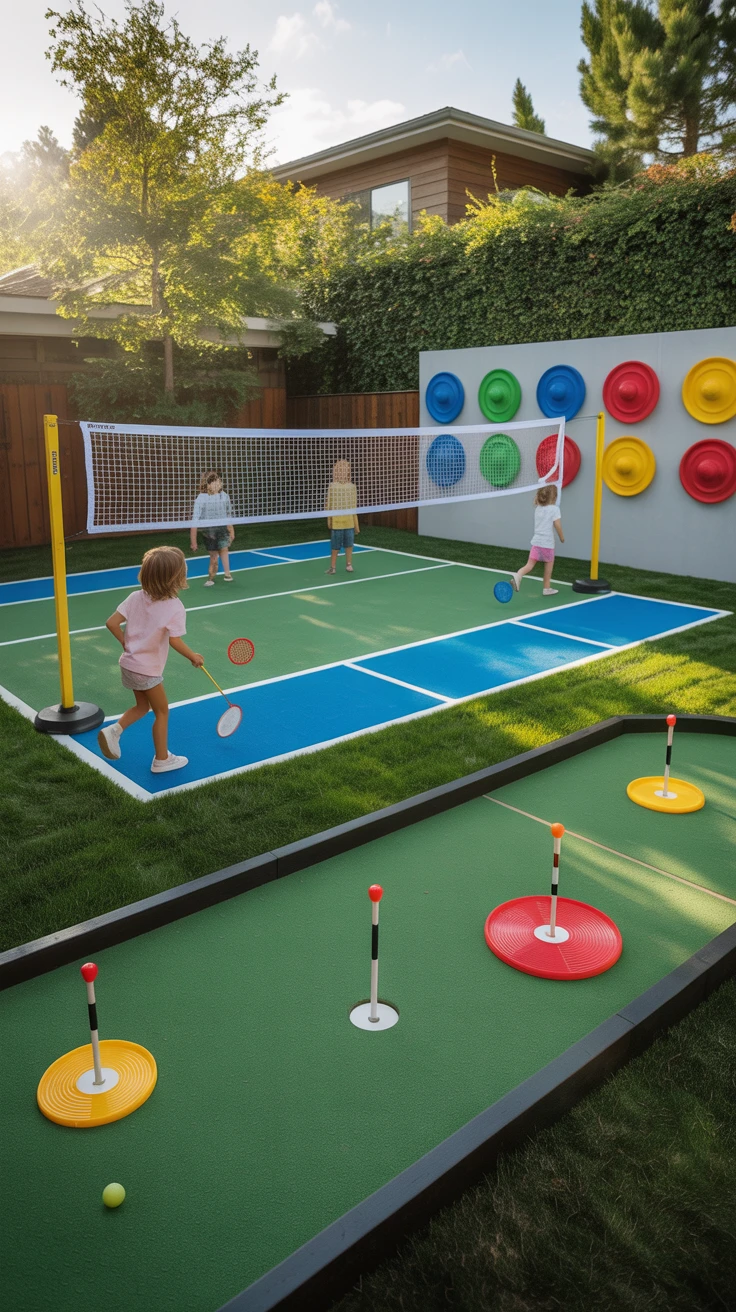
Transform your outdoor space into a multi-sport complex that grows with your children’s changing interests. These active outdoor playroom alternatives encourage physical development, teamwork, and healthy competition while burning endless energy.
The trick to creating a versatile sports center is designing adaptable spaces and investing in equipment that can be used for multiple activities. Think beyond the standard basketball hoop to create zones that can transform from one sport to another.
- Install an adjustable-height sports net that works for volleyball, badminton, and tennis
- Create a level playing surface with painted boundaries for various games
- Set up a target practice wall with different-sized targets for balls, frisbees, and bean bags
- Designate a “golf course” with putting cups embedded in the lawn
Pro Tip: Store sports equipment in an easily accessible, weather-resistant container right in the play area. When equipment is visible and available, kids are much more likely to engage in active play independently.
11. Sustainable Play Structures
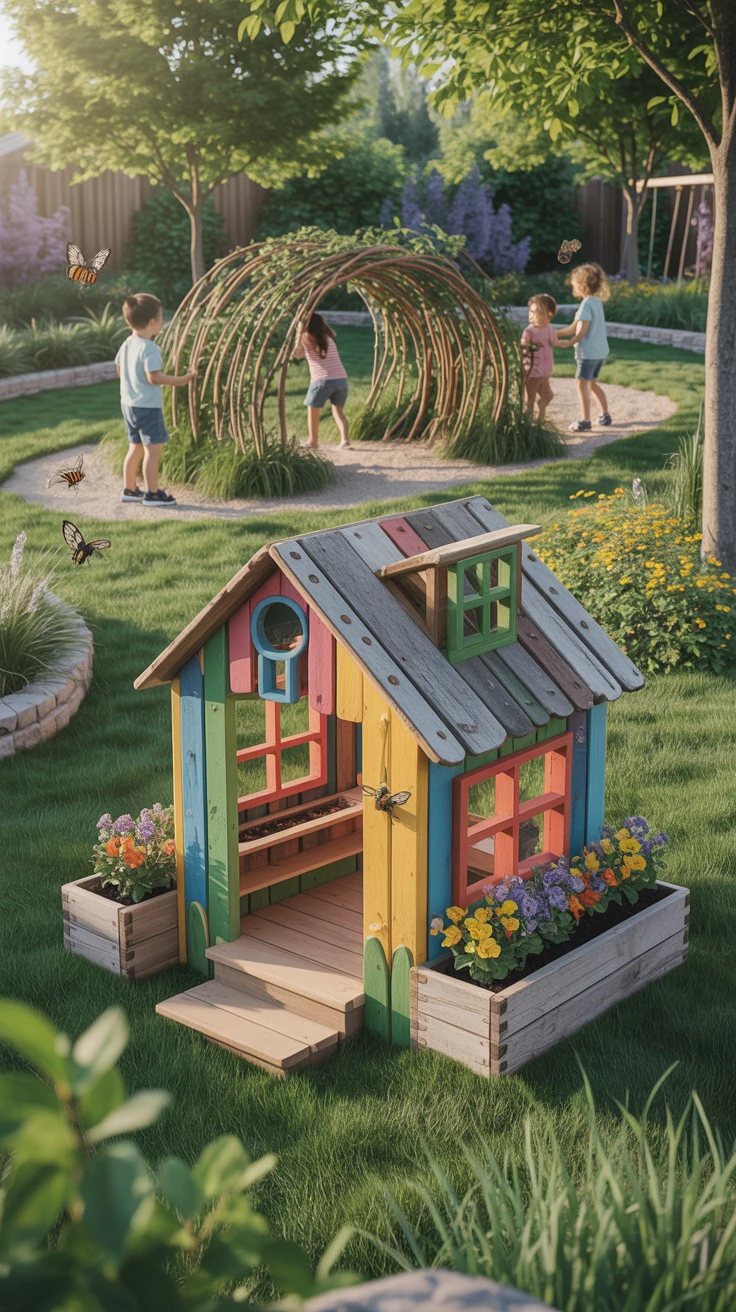
Eco-friendly outdoor playroom alternatives teach environmental stewardship while providing endless entertainment. Sustainable play structures use natural or reclaimed materials, work with the landscape rather than against it, and often incorporate elements that support local wildlife and plant communities.
The beauty of sustainable play spaces is they tend to blend harmoniously with your outdoor environment while providing rich play experiences. They’re typically more affordable than commercial play equipment and can be customized to your specific space.
- Build a living willow playhouse or tunnel that grows over time
- Create play structures from reclaimed wood, tires, or other upcycled materials
- Design a butterfly and bee garden with child-friendly observation areas
- Install a rain garden that doubles as a exploration zone during dry periods
My neighbor created the most amazing playhouse using reclaimed pallet wood and old windows. Not only was it practically free to build, but it’s become a neighborhood attraction with its whimsical design and child-planted flower boxes.

View on AmazonAs an Amazon Associate, I earn from qualifying purchases.

View on AmazonAs an Amazon Associate, I earn from qualifying purchases.
Pro Tip: Involve children in the building and maintenance of sustainable play spaces. The investment of their time and energy typically translates to greater appreciation and care for the area.
12. Multi-Season Outdoor Spaces
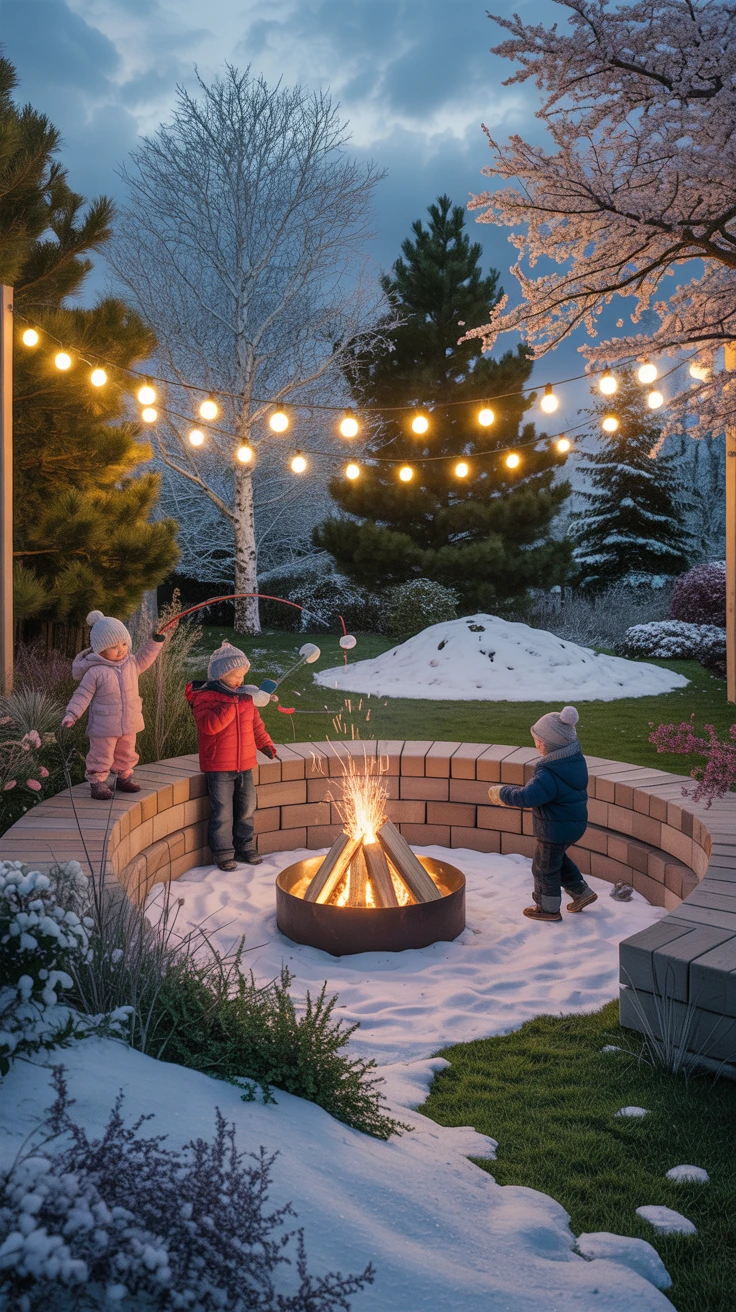
The ultimate outdoor playroom alternatives work year-round, adapting to seasonal changes while maintaining their play value. These thoughtfully designed spaces incorporate elements that shine in different weather conditions, ensuring outdoor play doesn’t stop when the temperature drops or soars.
Creating a multi-season space requires considering how each area will function throughout the year. Some features may hibernate during certain seasons, while others take center stage depending on the weather.
- Design sledding hills that become roll-down grass mounds in summer
- Install a fire pit (with appropriate safety measures) for winter marshmallow roasting
- Create a water play area that converts to a sand pit in cooler months
- Plant deciduous trees that provide summer shade but allow winter sun
Pro Tip: Create a seasonal outdoor play checklist with special activities that highlight each season’s unique offerings. This helps children appreciate the changing outdoor environment rather than seeing certain seasons as “bad” for outdoor play.
Key Takeaways
- Outdoor playroom alternatives offer developmental benefits that indoor spaces simply can’t match, including enhanced physical activity and deeper connection with nature.
- Many effective outdoor play spaces can be created with minimal investment using natural materials, repurposed items, and simple structures.
- The best outdoor play areas engage multiple senses and offer varied play experiences—from quiet contemplation to active physical challenges.
- Weather protection and seasonal adaptability extend the usability of outdoor playrooms throughout the year.
- Involving children in the design and creation of outdoor play spaces increases their engagement and sense of ownership.
Conclusion
Creating outdoor playroom alternatives isn’t just about moving toys outside—it’s about reimagining what play can look like when freed from four walls. The 12 ideas we’ve explored offer starting points for designing outdoor spaces that engage children’s bodies, minds, and spirits while connecting them with the natural world. Whether you implement one concept or combine several into your ultimate outdoor play zone, the benefits will extend far beyond entertainment.
Remember that the perfect outdoor playroom doesn’t need to be elaborate or expensive. Often, the simplest natural spaces become the most beloved play areas, offering open-ended possibilities that commercial equipment can’t match. So take that first step—designate a space, gather some materials, and watch as your outdoor playroom alternative becomes the heart of childhood adventures. Your kids will thank you with rosy cheeks, dirty knees, and memories that last a lifetime.
Frequently Asked Questions
-
How can I create an outdoor play space on a tight budget?
Focus on natural and repurposed materials. Tree stumps, large rocks, and fallen branches can become balance beams and climbing structures. Repurpose old furniture for mud kitchens or art stations. Check online marketplaces for second-hand outdoor toys, and don’t overlook the power of simple elements like a dirt digging patch or homemade obstacle course using household items. Often, the most affordable play spaces end up offering the richest play experiences.
-
What are the best weather-resistant materials for outdoor playrooms?
Cedar and redwood naturally resist rot and insects, making them excellent choices for wooden structures. For fabrics, look for marine-grade or outdoor-specific textiles with UV protection. Recycled plastic lumber offers durability without maintenance, while powder-coated metal resists rust. For storage, choose containers labeled “weatherproof” rather than merely “weather-resistant.” Finally, consider applying additional protective finishes to wooden elements, such as child-safe sealants for items that will have direct contact.
-
How do I make my outdoor play area safe for young children?
Start by ensuring appropriate fall surfaces under climbing equipment—rubber mulch, engineered wood fiber, or sand at proper depths. Regularly inspect all structures for splinters, protruding screws, or stability issues. Create clear boundaries using fencing or natural barriers like shrubs. Provide shade to prevent sun overexposure, and ensure water features have proper drainage and supervision. Finally, consider visibility—design your space so adults can monitor play from various vantage points without constantly hovering.
-
What outdoor play elements work best for multiple age groups?
Look for open-ended features that can be used differently depending on developmental stage. Sand and water play areas engage toddlers through elementary-aged children, just at different complexity levels. Climbing structures with varying challenge levels allow younger children to explore lower elements while older kids tackle more difficult sections. Natural materials like logs, stones, and loose parts adapt to different play scenarios across age groups. Finally, designated zones for different activities allow family members to engage in age-appropriate play simultaneously within the same overall space.
-
How do I maintain an outdoor playroom throughout the seasons?
Develop a seasonal maintenance schedule that includes cleaning, safety checks, and weatherproofing tasks. In fall, clean and store summer-specific items while preparing winter elements. Before spring, inspect all structures for winter damage and refresh play areas with new materials. Use weatherproof storage solutions for toys and materials, and consider quick-dry fabrics for soft elements. Teach children seasonal care routines, like covering sand areas before rain or bringing certain materials inside during extreme weather. Finally, document what works each season so you can quickly transition your space as the weather changes.
